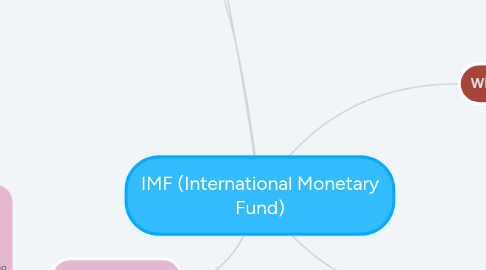IMF (International Monetary Fund)
by Owen Mac

1. How is the IMF funded
1.1. These quotas are proportional to the country's relative size in the world economy, for example the USA makes up 17.5% of the quotas, while a smaller country like Canada pays about 2.5% of the quotas
1.2. The main way the IMF is funded is through quotas paid by its member countries.
2. What do its critics/advocates say
2.1. Critics
2.1.1. They claim that the IMF deliberately supports capitalist military dictatorships friendly to American and European countries
2.1.2. They say that the IMF advocates austerity programs for countries in financial trouble, this means cutting social programs and increasing taxes to reduce government debt
2.1.3. Critics also say that the IMF does not actively promote democracy, labor rights, and human rights, and gives loans to corrupt military dictators to continue their regime
2.1.4. They say that the IMF is controlled by the US and has the main focus on the protection of the US's corporations
2.2. Advocates
2.2.1. They say that the IMF's goal is to promote financial stability, not make social changes
2.2.2. Its advocates maintain the fact that the IMF is simply a funding agency with little power to change any economies
2.2.3. They claim that economic stability is important for countries trying to build a strong democracy
3. Interesting Facts
3.1. In the 1960's, US President Richard Nixon made the dollar no longer convertible to gold in all places other than the foreign exchange market. By 1976, all economies had a floating exchange rate based on the supply and demand. This gave use to the IMF to monitor those because they were no longer fixed
3.2. Despite the fact that the IMF was created to help stabilize the global economy, since 1980, more than 100 countries have had a banking collapse, far more than in previous years
4. What it is
4.1. In 1944, delegates from the Allies met at Bretton- Woods to discuss the postwar economic effort. The end result was the Bretton-Woods agreement, where countries would maintain a fixed exchange rate based on the gold standard
4.2. The World Bank and IMF were both created as a result of this agreement.
4.3. The IMF is an agency of the UN, and was created to bring stability to international monetary affairs
5. What it does
5.1. While the World Bank deals in long term financial assistance, the IMF provides short term financial assistance through loans.
5.2. The IMF monitors global exchange rates and helps to expand world trade
5.3. The IMF assesses each country's economic situation and publishes its findings twice a year in the Global Financial Stability Report and the World Economic Outlook. It also discusses these findings with the authorities of the countries
5.4. The IMF also offers free technical training in the areas of banking and financial regulation.

